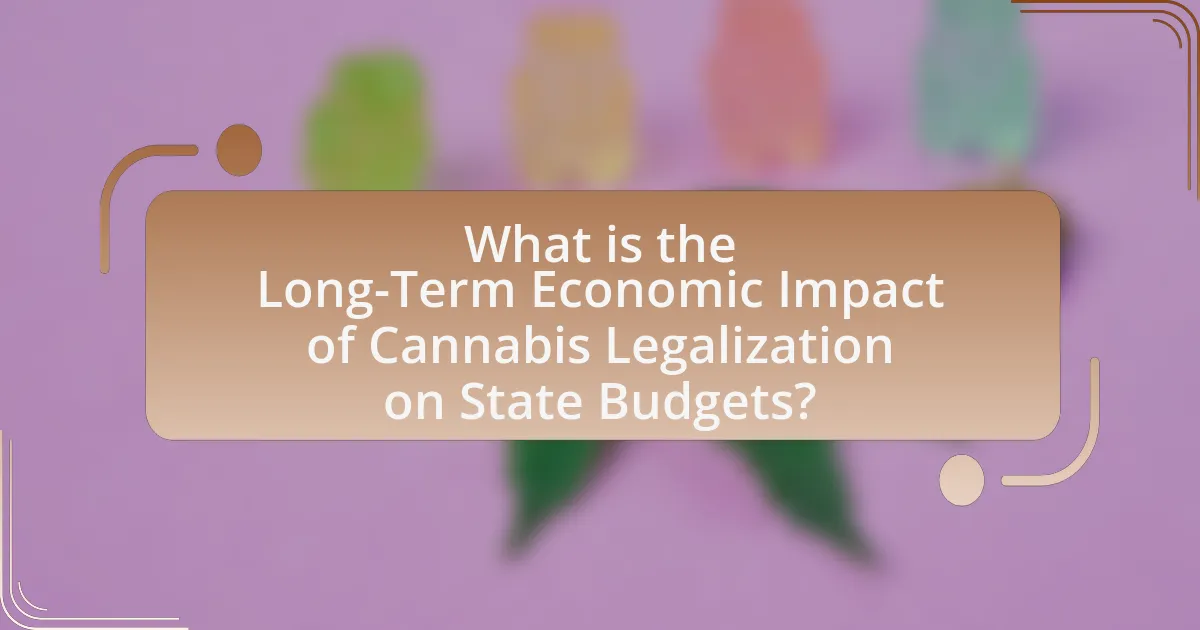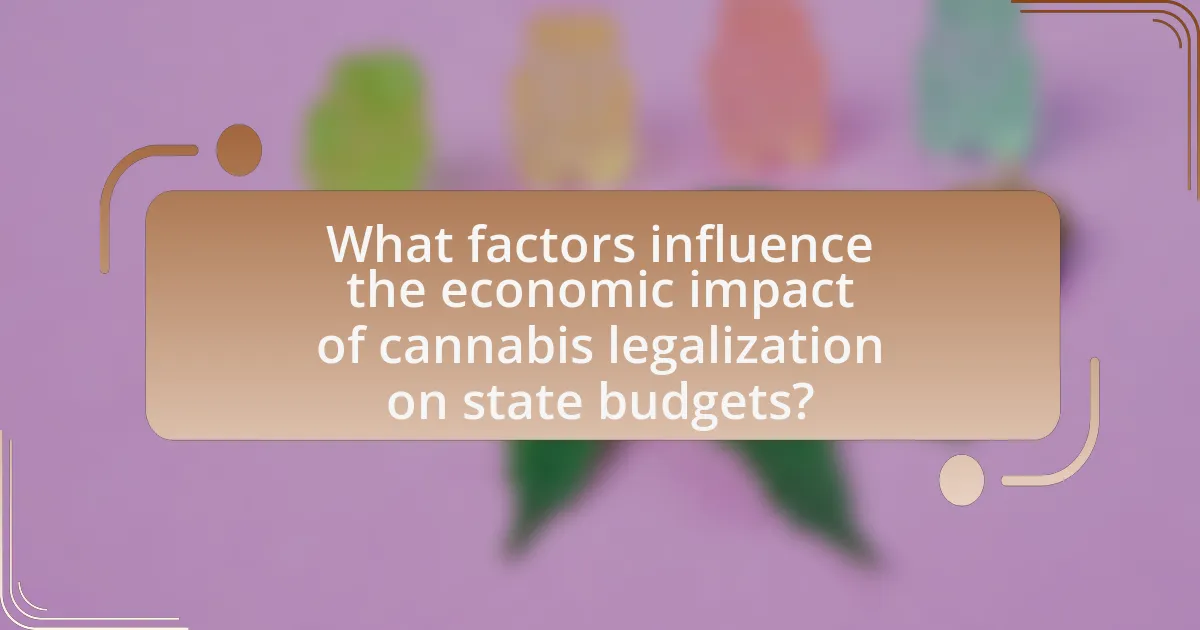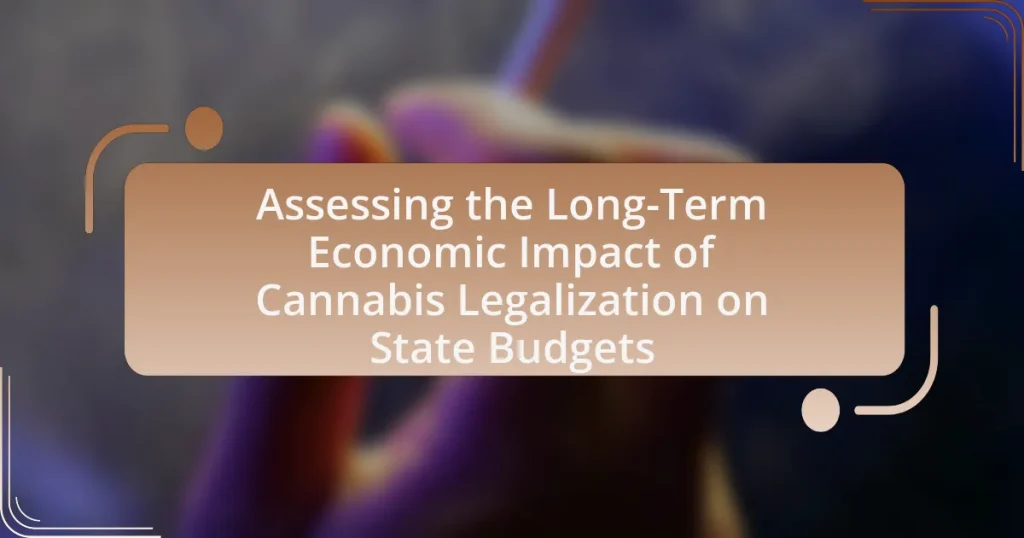The article examines the long-term economic impact of cannabis legalization on state budgets, highlighting its generally positive effects, such as increased tax revenues and reduced law enforcement costs. It details how states like Colorado and California have benefited financially from cannabis taxation, generating substantial revenue that supports public services. Additionally, the article discusses the potential costs associated with legalization, including regulatory expenses and public health impacts, while analyzing demographic factors and consumer behavior that influence cannabis market dynamics. It also explores employment trends within the cannabis industry and outlines best practices for maximizing economic benefits while avoiding common pitfalls.

What is the Long-Term Economic Impact of Cannabis Legalization on State Budgets?
The long-term economic impact of cannabis legalization on state budgets is generally positive, as it leads to increased tax revenues and reduced law enforcement costs. States that have legalized cannabis, such as Colorado and Washington, have reported significant tax revenue increases; for instance, Colorado generated over $1.7 billion in cannabis tax revenue from 2014 to 2021. Additionally, legalization reduces expenditures related to policing and incarceration for cannabis-related offenses, which can further enhance budgetary savings. These financial benefits contribute to overall economic growth and allow for reinvestment in public services.
How does cannabis legalization affect state revenue?
Cannabis legalization significantly increases state revenue through taxation and regulatory fees. For instance, states like Colorado and California have generated hundreds of millions in tax revenue since legalizing cannabis; Colorado reported over $387 million in tax revenue in 2020 alone. This revenue comes from sales taxes, excise taxes, and licensing fees imposed on cannabis businesses, contributing to state budgets and funding public services such as education and healthcare. Additionally, the legalization reduces law enforcement costs associated with cannabis prohibition, further enhancing overall state financial health.
What are the primary sources of revenue generated from cannabis legalization?
The primary sources of revenue generated from cannabis legalization include taxation, licensing fees, and sales revenue. Taxation on cannabis sales can significantly contribute to state budgets; for example, states like Colorado have reported over $1 billion in tax revenue since legalization in 2014. Licensing fees charged to cannabis businesses also provide a steady income stream for state governments, with fees varying based on the type of license and the scale of operations. Additionally, sales revenue from legal cannabis sales boosts local economies and can lead to increased job creation, further enhancing overall economic impact.
How do tax rates on cannabis sales influence state budgets?
Tax rates on cannabis sales significantly influence state budgets by generating substantial revenue that can be allocated to various public services. For instance, states like Colorado and California have reported millions in tax revenue since legalization, with Colorado collecting over $1.7 billion in cannabis tax revenue from 2014 to 2021. This revenue supports education, healthcare, and infrastructure projects, thereby enhancing overall state financial health. Additionally, higher tax rates can lead to increased compliance and regulation costs, which may offset some revenue gains, but the net effect typically remains positive for state budgets.
What are the potential costs associated with cannabis legalization?
The potential costs associated with cannabis legalization include regulatory expenses, public health impacts, and law enforcement adjustments. Regulatory expenses arise from the need to establish and maintain a framework for licensing, monitoring, and compliance, which can require significant government resources. Public health impacts may lead to increased healthcare costs due to potential rises in substance use disorders and related health issues, as evidenced by studies indicating higher emergency room visits in states that have legalized cannabis. Additionally, law enforcement may incur costs related to adjusting policies and training officers to handle new legal frameworks, which can strain budgets. These costs can offset some of the anticipated tax revenues from cannabis sales, as seen in states like Colorado, where initial revenue projections were tempered by these unforeseen expenses.
How do law enforcement and regulatory costs impact state budgets?
Law enforcement and regulatory costs significantly impact state budgets by diverting funds from other essential services and increasing overall expenditures. For instance, states that have legalized cannabis often face heightened law enforcement and regulatory expenses to ensure compliance and public safety, which can lead to budgetary strains. According to a report by the National Conference of State Legislatures, states like Colorado have allocated millions annually for regulatory frameworks and enforcement related to cannabis, which can exceed initial revenue projections from cannabis taxes. This financial burden can limit funding for education, healthcare, and infrastructure, ultimately affecting the state’s fiscal health and priorities.
What are the social costs related to cannabis legalization?
The social costs related to cannabis legalization include increased healthcare expenses, potential rises in substance abuse, and public safety concerns. Research indicates that states with legalized cannabis have seen a rise in emergency room visits related to cannabis use, which can strain healthcare systems. Additionally, studies show that while legalization may reduce some criminal justice costs, it can lead to increased incidents of impaired driving, raising public safety risks. For instance, a report from the National Highway Traffic Safety Administration found that cannabis use is linked to higher rates of traffic accidents, which can impose significant costs on law enforcement and emergency services.

What factors influence the economic impact of cannabis legalization on state budgets?
The economic impact of cannabis legalization on state budgets is influenced by several key factors, including tax revenue generation, regulatory costs, public health expenditures, and law enforcement savings. Tax revenue from cannabis sales can significantly boost state budgets; for instance, Colorado generated over $1.7 billion in tax revenue from cannabis between 2014 and 2020. Regulatory costs, however, can offset some of these gains, as states must invest in enforcement, quality control, and public education. Additionally, public health expenditures may rise due to increased usage, necessitating funding for addiction services and health programs. Conversely, savings in law enforcement costs from reduced cannabis-related arrests can positively impact budgets, as seen in states like California, which reported a decrease in law enforcement expenditures post-legalization. These factors collectively shape the overall economic impact of cannabis legalization on state budgets.
How do demographic factors affect cannabis revenue generation?
Demographic factors significantly influence cannabis revenue generation by determining consumer behavior, preferences, and purchasing power. For instance, age demographics show that younger adults, particularly those aged 18 to 34, are more likely to purchase cannabis products, contributing to higher sales in states where cannabis is legalized. According to a 2021 report by the Cannabis Business Times, states with a higher percentage of young adults have seen increased cannabis revenue, as this age group tends to spend more on cannabis compared to older demographics. Additionally, income levels affect spending patterns; higher-income individuals are more likely to purchase premium cannabis products, thereby increasing overall revenue. Furthermore, racial and ethnic demographics can shape market trends, as different groups may have varying levels of acceptance and consumption rates of cannabis, impacting sales in diverse communities. Overall, understanding these demographic factors is crucial for predicting and maximizing cannabis revenue generation in legalized markets.
What role does population size play in cannabis market potential?
Population size significantly influences cannabis market potential by determining the number of potential consumers and the overall demand for cannabis products. A larger population typically correlates with a higher number of potential users, which can lead to increased sales and revenue for cannabis businesses. For instance, states with larger populations, such as California and Colorado, have seen substantial growth in their cannabis markets, generating billions in sales. According to a report by the Marijuana Policy Group, Colorado’s cannabis market reached over $1.5 billion in sales in 2020, driven by its sizable population. Thus, population size is a critical factor in assessing the economic viability and growth potential of the cannabis market.
How does consumer behavior influence cannabis sales and taxation?
Consumer behavior significantly influences cannabis sales and taxation by determining demand patterns and spending habits. For instance, increased consumer acceptance and preference for cannabis products lead to higher sales volumes, which in turn generate greater tax revenue for states. According to a report from the Colorado Department of Revenue, cannabis sales in Colorado reached over $2 billion in 2020, contributing approximately $387 million in tax revenue, illustrating the direct correlation between consumer behavior and financial outcomes for state budgets. Additionally, consumer preferences for specific product types, such as edibles or concentrates, can shape market trends and influence tax structures, as states may adjust tax rates based on product categories to optimize revenue.
What economic models are used to assess the impact of cannabis legalization?
Economic models used to assess the impact of cannabis legalization include cost-benefit analysis, econometric modeling, and general equilibrium models. Cost-benefit analysis evaluates the financial implications of legalization by comparing the costs of enforcement and health impacts against tax revenues and economic growth. Econometric modeling utilizes statistical methods to analyze historical data and predict future economic outcomes related to cannabis markets. General equilibrium models assess the broader economic effects by considering interactions between various sectors, including labor, consumption, and taxation. These models provide a structured approach to understanding the multifaceted economic implications of cannabis legalization on state budgets.
What are the key assumptions in these economic models?
The key assumptions in economic models assessing the long-term impact of cannabis legalization on state budgets include the expectation of increased tax revenue from cannabis sales, the estimation of reduced law enforcement costs related to cannabis prohibition, and the prediction of economic growth through job creation in the cannabis industry. These models often assume that consumer demand for legal cannabis will remain stable or grow over time, and they typically factor in potential public health costs associated with increased cannabis use. Additionally, they assume that the regulatory framework will be effectively implemented, ensuring compliance and maximizing revenue. These assumptions are supported by data from states that have legalized cannabis, which have reported significant increases in tax revenue and reductions in certain law enforcement expenditures.
How do different states’ approaches to legalization affect model outcomes?
Different states’ approaches to legalization significantly influence model outcomes by affecting tax revenue, regulatory costs, and market dynamics. For instance, states like Colorado and Washington, which implemented comprehensive regulatory frameworks, have seen substantial tax revenues exceeding $1 billion annually, while states with more restrictive measures, such as New Jersey, have faced challenges in establishing a robust market, resulting in lower-than-expected revenue. Additionally, varying taxation rates impact consumer behavior; higher taxes in some states can lead to increased black market activity, skewing model predictions. These differences highlight how regulatory environments shape economic outcomes, as evidenced by studies showing that states with lower barriers to entry and competitive tax structures tend to generate more favorable economic impacts.

What are the long-term trends observed in states that have legalized cannabis?
Long-term trends observed in states that have legalized cannabis include increased tax revenue, reduced law enforcement costs, and changes in public health outcomes. For instance, states like Colorado and California have reported significant tax revenues from cannabis sales, with Colorado generating over $1.7 billion in tax revenue since legalization in 2014. Additionally, law enforcement costs related to cannabis offenses have decreased, allowing resources to be reallocated to other areas. Public health outcomes have shown mixed results, with some studies indicating a decrease in opioid prescriptions and others highlighting concerns about increased cannabis use among adolescents. These trends illustrate the multifaceted economic and social impacts of cannabis legalization on state budgets.
How has cannabis legalization affected employment rates in these states?
Cannabis legalization has generally led to increased employment rates in states that have enacted such laws. For instance, a report from the Colorado Department of Revenue indicated that the cannabis industry created over 18,000 jobs in Colorado alone by 2019, contributing significantly to the state’s economy. Additionally, a study by the University of California, Berkeley, found that states with legalized cannabis experienced a 5% increase in overall employment rates compared to states without legalization. This trend is attributed to the growth of the cannabis sector, which includes cultivation, distribution, and retail, as well as ancillary businesses that support the industry.
What types of jobs are created as a result of cannabis legalization?
Cannabis legalization creates a variety of jobs across multiple sectors. These jobs include roles in cultivation, such as growers and agricultural technicians, which are essential for producing cannabis plants. Additionally, the industry generates positions in processing, including extraction technicians and quality control specialists, responsible for refining cannabis products. Retail jobs also emerge, with dispensaries hiring budtenders, sales associates, and managers to facilitate consumer purchases. Furthermore, ancillary services expand, leading to opportunities in marketing, legal consulting, and compliance, as businesses navigate regulations. According to a report by Leafly, the cannabis industry supported over 300,000 jobs in the United States as of 2021, highlighting the significant employment impact of legalization.
How does employment in the cannabis industry compare to other sectors?
Employment in the cannabis industry is growing at a faster rate compared to many traditional sectors. As of 2022, the cannabis industry employed over 400,000 workers in the United States, reflecting a growth rate of approximately 27% from the previous year, which is significantly higher than the average growth rate of 3% for all industries. This rapid expansion is driven by increasing legalization and acceptance of cannabis, leading to job creation in cultivation, distribution, retail, and ancillary services. Additionally, a report by Leafly indicated that the cannabis sector has the potential to create over a million jobs by 2025, further emphasizing its comparative growth potential against other sectors.
What lessons can be learned from states that have legalized cannabis?
States that have legalized cannabis demonstrate that regulated markets can generate significant tax revenue and reduce law enforcement costs. For instance, Colorado reported over $1.7 billion in cannabis tax revenue from 2014 to 2020, which contributed to funding education and public health initiatives. Additionally, states like Washington have seen a decrease in cannabis-related arrests, leading to lower criminal justice expenditures. These examples illustrate that legalization can positively impact state budgets by providing new revenue streams while decreasing costs associated with prohibition enforcement.
What best practices have emerged from successful cannabis legalization efforts?
Best practices from successful cannabis legalization efforts include implementing a comprehensive regulatory framework, prioritizing public health and safety, and ensuring equitable access to the market. A comprehensive regulatory framework, as seen in states like Colorado, establishes clear guidelines for cultivation, distribution, and sales, which helps to minimize illegal market activity. Prioritizing public health and safety involves educating consumers about responsible use and preventing underage access, as demonstrated by California’s extensive public awareness campaigns. Ensuring equitable access to the market, particularly for communities disproportionately affected by past cannabis prohibition, is evident in Illinois’ social equity programs that provide support for minority-owned businesses. These practices contribute to sustainable economic growth and increased tax revenues, as evidenced by Colorado generating over $1.7 billion in tax revenue since legalization in 2014.
How can states avoid common pitfalls associated with cannabis legalization?
States can avoid common pitfalls associated with cannabis legalization by implementing comprehensive regulatory frameworks that prioritize public health, safety, and education. Establishing clear guidelines for cultivation, distribution, and sales helps mitigate risks such as illegal market persistence and underage access. For instance, Colorado’s regulatory model includes strict age verification processes and robust public health campaigns, which have contributed to a decrease in youth cannabis use since legalization. Additionally, states should invest in ongoing research and data collection to monitor the impacts of legalization, allowing for timely adjustments to policies based on evidence. This approach not only enhances compliance but also fosters public trust and ensures that tax revenues are effectively allocated to address potential social issues arising from legalization.
What strategies can states implement to maximize the economic benefits of cannabis legalization?
States can maximize the economic benefits of cannabis legalization by implementing comprehensive regulatory frameworks, optimizing tax structures, and investing in public education and health programs. A well-defined regulatory framework ensures product safety and quality, which can enhance consumer trust and increase market participation. For instance, Colorado’s regulatory approach has generated over $1 billion in tax revenue since legalization in 2014, demonstrating the financial potential of a structured market.
Additionally, states can adopt competitive tax rates that encourage legal sales while discouraging black market activity. For example, Oregon’s lower tax rate has helped maintain a robust legal market, contributing to significant state revenue.
Investing in public education and health initiatives can further enhance economic benefits by addressing potential social issues related to cannabis use, thereby fostering a healthier workforce and reducing long-term healthcare costs. Research from the National Bureau of Economic Research indicates that states with proactive public health campaigns see better economic outcomes post-legalization.
By focusing on these strategies, states can effectively harness the economic potential of cannabis legalization while ensuring public safety and health.


